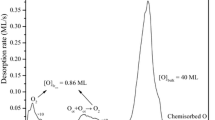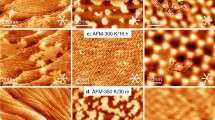Abstract
Surface reactions of formaldehyde with reduced TiO2(110) surfaces have been studied using variable-temperature scanning tunneling microscopy (STM) and density functional theory (DFT). STM images taken from a same area at various temperatures clearly show that formaldehyde preferentially adsorbs on the bridge-bonded oxygen (Ob) vacancy (VO) defect sites. Bias-dependent STM images show that the STM features corresponding to both the Ti-bound CH2O and the VO-bound CH2O are positioned between the Ob row and the Ti row. While the VO-bound formaldehyde rotates at 95 K, the Ti-bound CH2O does not. The VO-bound CH2O starts to diffuse along the Ob row as –CH2– at ~170 K and starts to diffuse along the Ti row as an intact molecule at ~215 K. However, the stabilities and the configurations of the Ti-bound and VO-bound formaldehyde calculated using DFT are not in line with the experimental results. The discrepancy between the experiment and theory indicates the presence of a complex charge distribution related to the surface defects.








Similar content being viewed by others
References
Henderson MA, Lyubinetsky I (2013) Molecular-level insights into photocatalysis from scanning probe microscopy studies on TiO2(110). Chem Rev 113:4428–4455
Vohs JM (2013) Site requirements for the adsorption and reaction of oxygenates on metal oxide surfaces. Chem Rev 113:4136–4163
Hoang S, Berglund SP, Hahn NT, Bard AJ, Mullins CB (2012) Enhancing visible light photo-oxidation of water with TiO2 nanowire arrays via cotreatment with H2 and NH3: synergistic effects between Ti3+ and N. J Am Chem Soc 134:3659–3662
Li Z, Zhang Z, Kay BD, Dohnalek Z (2011) Polymerization of formaldehyde and acetaldehyde on ordered (WO3)3 films on Pt(111). J Phys Chem C 115:9692–9700
Qiu H, Idriss H, Wang Y, Woell C (2008) Carbon-carbon bond formation on model titanium oxide surfaces: identification of surface reaction intermediates by high-resolution electron energy loss spectroscopy. J Phys Chem C 112:9828–9834
Lu G, Linsebigler A, Yates J (1994) Ti3+ defect sites on TiO2(110)—production and chemical-detection of active-sites. J Phys Chem 98:11733–11738
Xu C, Yang W, Guo Q, Dai D, Minton TK, Yang X (2013) Photoinduced decomposition of formaldehyde on a TiO2(110) surface, assisted by bridge-bonded oxygen atoms. J Phys Chem Lett 4:2668–2673
Zehr RT, Henderson MA (2008) Acetaldehyde photochemistry on TiO2(110). Surf Sci 602:2238–2249
Idriss H, Barteau M (1996) Selectivity and mechanism shifts in the reactions of acetaldehyde on oxidized and reduced TiO2(001) surfaces. Catal Lett 40:147–153
Clawin PM, Friend CM, Al-Shamery K (2014) Defects in surface chemistry-reductive coupling of benzaldehyde on rutile TiO2(110). Chem Eur J 20:4506
Benz L, Haubrich J, Jensen SC, Friend CM (2011) Molecular imaging of reductive coupling reactions: interstitial-mediated coupling of benzaldehyde on reduced TiO2(110). ACS Nano 5:834–843
Haubrich J, Kaxiras E, Friend CM (2011) The role of surface and subsurface point defects for chemical model studies on TiO2: a first-principles theoretical study of formaldehyde bonding on rutile TiO2(110). Chem Eur J 17:4496–4506
Muir JMR, Idriss H (2013) Formaldehyde adsorption geometry and energies over TiO2(110) rutile surface. Chem Phys Lett 572:125–129
Liu H, Wang X, Pan C, Liew KM (2012) First-principles study of formaldehyde adsorption on TiO2 rutile (110) and anatase (001) surfaces. J Phys Chem C 116:8044–8053
Xia Y, Ye J, Murray P, Ali A, Ge Q, Zhang Z (2013) Imaging reactions of acetone with oxygen adatoms on partially oxidized TiO2(110). Phys Chem Chem Phys 15:13897–13901
Xia Y, Zhang B, Ye J, Ge Q, Zhang Z (2012) Acetone-assisted oxygen vacancy diffusion on TiO2(110). J Phys Chem Lett 3:2970–2974
Horcas I, Fernandez R, Gomez-Rodriguez JM, Colchero J, Gomez-Herrero J, Baro AM (2007) WSXM: a software for scanning probe microscopy and a tool for nanotechnology. Rev Sci Instrum 78:013705
Mills G, Jonsson H, Schenter G (1995) Reversible work transiton state theory: application to dissociative adsorption of hydrogen. Surf Sci 324:305–337
Jonsson H (2000) Theoretical studies of atomic-scale processes relevant to crystal growth. Annu Rev Phys Chem 51:623–653
Zhang Z, Ge Q, Li SC, Kay BD, White JM, Dohnalek Z (2007) Imaging intrinsic diffusion of bridge-bonded oxygen vacancies on TiO2(110). Phys Rev Lett 99:126105
Dohnalek Z, Lyubinetsky I, Rousseau R (2010) Thermally-driven processes on rutile TiO2(1 1 0)-(1 × 1): a direct view at the atomic scale. Prog Surf Sci 85:161–205
Diebold U (2003) The surface science of titanium dioxide. Surf Sci Rep 48:53–229
Zhu K, Wang Z, Xia Y, Dohnalek Z, Lyubinetsky I, Park KT, Zhang Z Manuscript in preparation
Kumagai T, Hanke F, Gawinkowski S, Sharp J, Kotsis K, Waluk J, Persson M, Grill L (2013) Thermally and vibrationally induced tautomerization of single porphycene molecules on a Cu(110) surface. Phys Rev Lett 111:246101
Papageorgiou AC, Pang CL, Chen Q, Thornton G (2007) Low-dimensional, reduced phases of ultrathin TiO2. ACS Nano 1:409–414
Minato T, Sainoo Y, Kim Y, Kato HS, Aika K, Kawai M, Zhao J, Petek H, Huang T, He W, Wang B, Wang Z, Zhao Y, Yang J, Hou JG (2009) The electronic structure of oxygen atom vacancy and hydroxyl impurity defects on titanium dioxide (110) surface. J Chem Phys 130:124502
Deskins NA, Rousseau R, Dupuis M (2009) Localized electronic states from surface hydroxyls and polarons in TiO2(110). J Phys Chem C 113:14583–14586
Di Valentin C, Pacchioni G, Selloni A (2006) Electronic structure of defect states in hydroxylated and reduced rutile TiO2(110) surfaces. Phys Rev Lett 97:166803
Finazzi E, Di Valentin C, Pacchioni G (2009) Nature of Ti interstitials in reduced bulk anatase and rutile TiO2. J Phys Chem C 113:3382–3385
Wendt S, Sprunger PT, Lira E, Madsen GKH, Li Z, Hansen JO, Matthiesen J, Blekinge-Rasmussen A, Laegsgaard E, Hammer B, Besenbacher F (2008) The role of interstitial sites in the Ti3d defect state in the band gap of titania. Science 320:1755–1759
Madsen GKH, Hammer B (2009) Effect of subsurface Ti-interstitials on the bonding of small gold clusters on rutile TiO2(110). J Chem Phys 130:044704
Zhang Z, Rousseau R, Gong J, Li SC, Kay BD, Ge Q, Dohnalek Z (2008) Vacancy-assisted diffusion of alkoxy species on rutile TiO2(110). Phys Rev Lett 101:156103
Phillips KR, Jensen SC, Baron M, Li S, Friend CM (2013) Sequential photo-oxidation of methanol to methyl formate on TiO2(110). J Am Chem Soc 135:574–577
Acknowledgments
Acknowledgment is made to the Donors of the American Chemical Society Petroleum Research Fund for partial support of this research. MT and QG acknowledge support by U.S. Department of Energy (DOE) Basic Energy Science (BES) Grant DE-FG-05ER46231. ZW, IL, and ZD were supported by the U.S. DOE BES, Division of Chemical Sciences, Biosciences and Geosciences. Calculations and part of the experimental work and part of the experiments were performed using EMSL, a national scientific user facility sponsored by the DOE Office of Biological and Environmental Research and located at Pacific Northwest National Laboratory (PNNL). PNNL is operated for the U.S. DOE by Battelle Memorial Institute under Contract No. DE-AC06-76RLO 1830.
Author information
Authors and Affiliations
Corresponding authors
Rights and permissions
About this article
Cite this article
Zhang, Z., Tang, M., Wang, ZT. et al. Imaging of Formaldehyde Adsorption and Diffusion on TiO2(110). Top Catal 58, 103–113 (2015). https://doi.org/10.1007/s11244-014-0349-6
Published:
Issue Date:
DOI: https://doi.org/10.1007/s11244-014-0349-6




